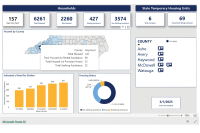WCU invites student and faculty input on campus master plan
 Western Carolina University is open to suggestions — from students, faculty and the general public — as it undergoes a campus-wide planning process that will steer infrastructure at the institution for the coming decade.
Western Carolina University is open to suggestions — from students, faculty and the general public — as it undergoes a campus-wide planning process that will steer infrastructure at the institution for the coming decade.
After beginning its Campus Master Plan last fall, WCU leaders have held forums in the community and on campus, but Monday it tried a new approach: a drop-in style session in the A.K. Hinds University Center in the heart of the university.
Faculty stopped by to share their thoughts and concerns with WCU administrators and consultants working on the master plan. Students wandered by after grabbing a sandwich in the nearby cafeteria and scribbled their favorite studying and socializing spots on a gigantic tag board in the hallway.
“We need another big hangout spot apart from the fountain,” said WCU sophomore Tiffany Cantrell, in reference to the campus’ main plaza. On a sunny day like Monday, students flocked to the fountain, which is bordered by fields of green grass, trees and the looming campus clock tower.
But Dan Grube, director of the School of Teaching and Learning, offered perhaps a more economical and simpler suggestion: more benches in the places that already exist.
Related Items
“Seems like it might be nice to have some seating areas where people could congregate and have lunch,” Grube said.
The panel of experts, sitting behind booths dedicated to different facets of campus infrastructure — community and heritage, security, transportation and parking, technology and sustainability — fielded all sorts of questions and suggestions about how the campus could be better.
One student suggested to those manning the transportation and parking booth that they bring back the bike rental service and the dedicated shuttle that once transported students from the upper reaches of campus. He also added that it’s hard to get a decent bite to eat near the Reynolds Residence Hall where he lives.
“You have to either have it in your room or you have to leave,” said Colin Cunningham, a junior.
Cunningham also thought the Catamount statute in the center of the roundabout at the main entrance was a bit out of place and would be better served in the center of the campus rather.
“Bigger campuses, like Appalachian State, have their mascots where the students hang out, not in front of the campus,” Cunningham said.
But it wasn’t necessarily what was at the heart of campus that concerned faculty member Dave Hudson. He paid a visit to the drop-in input session to remind planners not to forget the surrounding community while developing the landscape at WCU. He said the university would be better served if it took into consideration what lies outside its borders during the planning process.
“My thoughts were for them to keep that in the back of their minds,” Hudson said, who lives in Cullowhee just outside the campus boundaries. “It’s all part of the big thing of developing a more university town feel.”
Despite the mishmash of campus betterment ideas thrown out to those involved in the planning process, Melissa Wargo, a faculty member at WCU and co-chairwoman of the master planning committee, said that was just what they were looking for. Wargo said the strategy was to grab feedback from students and staff before they took off for the summer, and it was better than expecting them to show up at some of the meetings.
“This is a good way to solicit that information rather than somebody in a room with a panel talking at them,” Wargo said.
Instead, the panel of consultants lined the hallway at the University Center and chatted comfortably with visitors. John Dreiling, a project manager with an architectural and planning firm in Virginia, organized the team of consultants. They include experts in the fields of civil engineering, information technology, curriculums, transportation and sustainability.
They will guide the master plan and work with WCU administrators until the long process is complete this fall.
A preliminary plan is expected to be completed by early September, followed by a series of campus and community presentations for reaction in October and November. After revisions based on that feedback, the final master plan should be ready for consideration by the WCU Board of Trustees at its meeting in December.
“At this point we’re early in our process of master planning,” Dreiling said. “We’re doing data collection and trying to find out as much as we can about the university and its environment.”
In addition to soliciting general input, the team will be meeting with deans, department heads and members of a master planning steering committee and several task forces focused on specific areas of the campus master plan.
Dreiling said all the information they gather will be analyzed and incorporated into the plan. However, he said some areas of the campus that need work are already starting to rise above others. Transportation and parking are themes that have often been repeated throughout the process, as are technology issues and access to wifi from certain points on campus.
Sustainability and preservation of the university’s green spaces is another topic mentioned frequently.
The planning process is not limited to what can be added to the campus — it’s also assessing how current facilities are being utilized and which buildings and areas could be re-purposed or altered.
Once completed, the master plan will serve as a guidebook for future additions, expansion and physical changes made on campus. Yet, before those ideas are taken from their paper form and put into action in coming years, other factors need to come into play.
“Of course with all these institutions there’s the question of funding and budgets,” Dreiling said.









